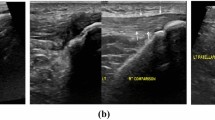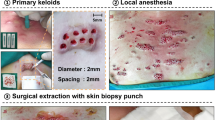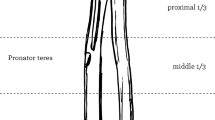Abstract
Background
This study addresses factors associated with apparent resolution and recurrence of triggering using data from providers with various treatment strategies.
Methods
A retrospective review identified 878 adult patients with 1,210 Quinnell grade 2 or 3 trigger fingers that had one or more corticosteroid injections by one of three surgeons between 2001 and 2011. Two surgeons injected dexamethasone, but one had patients return 1 month after injection and was quick to recommend surgery (strategy A) and the other had patients return 2 months after injection, offered another injection or surgery, and followed the patient’s preference. One surgeon used triamcinolone, had patients return only if the injection did not work, and waited at least 3 months to offer surgery. Factors associated with apparent resolution and recurrence of triggering were sought in bivariable and multivariable statistical analysis.
Results
Triamcinolone injection was associated with more frequent apparent resolution (83 %), than dexamethasone injection (30 %). Apparent resolution of triggering was also associated with a delayed surgery treatment strategy (B and C) and the affected finger (long and ring fingers were less likely to resolve). Return with triggering after documented or presumed resolution occurred in 188 fingers (33 %) and was associated with triamcinolone injection, index, long and ring finger, and orally treated non-insulin-dependent diabetes mellitus. Strategy A had the lowest initial apparent resolution rate, the highest proportion of patients having surgery, and the lowest final triggering rate of 10 %.
Conclusion
Both treatment strategy and type of corticosteroid determine apparent resolution and recurrence rates.
Similar content being viewed by others
References
Altman E. Clinical commentary in response to: effectiveness of splinting for the treatment of trigger finger. J Hand Ther. 2008;21(4):344–6.
Anderson B, Kaye S. Treatment of flexor tenosynovitis of the hand (‘trigger finger’) with corticosteroids, a prospective study of the response to local injection. Arch Intern Med. 1991;151(1):153–6.
Benson LS, Ptaszek AJ. Injection versus surgery in the treatment of trigger finger. J Hand Surg. 1997;22A(1):138–44.
Fleisch SB, Spindler KP, Lee DH. Corticosteroid injections in the treatment of trigger finger: a level I and II systematic review. J Am Acad Orthop Surg. 2007;15(3):166–71.
Freiberg A, Mulholland RS, Levine R. Nonoperative treatment of trigger fingers and thumbs. J Hand Surg Am. 1989;14(3):553–8.
Gyuricza C, Umoh E, Wolfe SW. Multiple pulley rupture following corticosteroid injection for trigger digit: case report. J Hand Surg. 2009;34A(8):1444–8.
Kazuki K, Egi T, Okada M, et al. Clinical outcome of extrasynovial steroid injection for trigger finger. Hand Surg. 2006;11(1–2):1–4.
Kerrigan CL, Stanwix MG. Using evidence to minimize the cost of trigger finger care. J Hand Surg. 2009;34A(6):997–1005.
Kraemer BA, Young VL, Arfken C. Stenosing flexor tenosynovitis. South Med J. 1990;83(7):806–11.
Lambert MA, Morton RJ, Sloan JP. Controlled study of the use of local steroid injection in the treatment of trigger finger and thumb. J Hand Surg. 1992;17B(1):69–70.
Maneerit J, Sriworakun C, Budhraja N, et al. Trigger thumb: results of a prospective randomised study of percutaneous release with steroid injection versus steroid injection alone. J Hand Surg. 2003;28B(6):586–9.
Marks MR, Gunther SF. Efficacy of cortisone injection in treatment of trigger fingers and thumbs. J Hand Surg. 1989;14A(4):722–7.
Murphy D, Failla JM, Koniuch MP. Steroid versus placebo injection for trigger finger. J Hand Surg. 1995;20A(4):628–31.
Newport ML, Lane LB, Stuchin SA. Treatment of trigger finger by steroid injection. J Hand Surg. 1990;15A(5):748–50.
Park J, Dumanian GA. Shower emboli and digital necrosis after a single corticosteroid injection for trigger thumb: case report. J Hand Surg. 2009;34A(2):313–6.
Quinnell RC. Conservative management of trigger finger. Practitioner. 1980;224(1340):187–90.
Ring D, Lozano-Calderon S, Shin R, et al. A prospective randomized controlled trial of injection of dexamethasone versus triamcinolone for idiopathic trigger finger. J Hand Surg. 2008;33A(4):516–22. discussion 523–514.
Rozental TD, Zurakowski D, Blazar PE. Trigger finger: prognostic indicators of recurrence following corticosteroid injection. J Bone Joint Surg. 2008;90A(8):1665–72.
Saldana MJ. Trigger digits: diagnosis and treatment. J Am Acad Orthop Surg. 2001;9(4):246–52.
van Ijsseldijk AL, de Wilt JH, Lameris TW, et al. [Topical corticosteroid injection for ‘trigger finger’: good short-term results, but fairly high risk of recurrence]. Ned Tijdschr Geneeskd. 1998;142(9):457–9.
Yam A, Teoh LC, Yong FC. Necrotising fasciitis after corticosteroid injection for trigger finger: a severe complication from a 'safe' procedure. J Hand Surg. 2009;34B(5):689–90.
Yamada K, Masuko T, Iwasaki N. Rupture of the flexor digitorum profundus tendon after injections of insoluble steroid for a trigger finger. J Hand Surg. 2011;36B(1):77–8.
Zyluk A, Jagielski G. Percutaneous A1 pulley release vs steroid injection for trigger digit: the results of a prospective, randomized trial. J Hand Surg. 2011;36B(1):53–6.
Conflict of Interest
All named authors hereby declare that they have no conflicts of interest to disclose related to this study.
Author information
Authors and Affiliations
Corresponding author
Additional information
Declaration
The authors adhere to the ethical standards described by the Committee on Publication Ethics and the International Committee of Medical Journal Editors. The study was completed under an IRB-approved protocol.
About this article
Cite this article
Mol, M.F., Neuhaus, V., Becker, S.J.E. et al. Resolution and recurrence rates of idiopathic trigger finger after corticosteroid injection. HAND 8, 183–190 (2013). https://doi.org/10.1007/s11552-013-9493-x
Published:
Issue Date:
DOI: https://doi.org/10.1007/s11552-013-9493-x




